Tissues
1.0Introduction
The living organisms are either unicellular like Amoeba or multicellular like human beings. In unicellular organism all the life processes are carried out within a single cell. In multicellular organisms, because of increase in body size, it is difficult for each cell to efficiently cope with the vast variety of the physiological needs of the organisms, so cells differentiate into specific tissues tomessages, blood flows to transport oxygen, food, hormones and waste materials. In plants vascular tissues conduct food, water and minerals from one part of the plant to other part. So multicellular organism performs division of labour.
- The term tissue was coined by Bichat. The study of internal structure of any part of an organism with the help of section cutting is called anatomy. The study of tissue with the help of microscope is called histology. Tissue A group of cells that are similar in structure and work together to achieve a particular function is called tissue.
2.0Importance of tissues
(i) Workload of individual cell decreases. Tissues become organized to form organs and organs into organ systems. Formation of tissues has brought about division of labour in multicellular organisms. (ii) Multicellular organisms have higher survival due to improved body organization and higher efficiency of functions.
- Multicellular organisms are made up of more than one cell.
3.0Plant tissue
Plants are stationary so they require more of supportive tissue for obtaining structural strength. Most of these tissues are dead and hence they provide more mechanical strength and they require less energy for their maintenance. The growth of plants is limited to certain regions. In these certain regions, growing tissues are present, which have capacity to divide throughout life.
Why plants consume less energy as compared to animals?
Plants require less energy as they do not move from place to place and possess dead tissues.
4.0Classification of Plant Tissues
Plant tissues can be classified into two groups on the basis of their dividing capacity, meristematic tissue and permanent tissue.
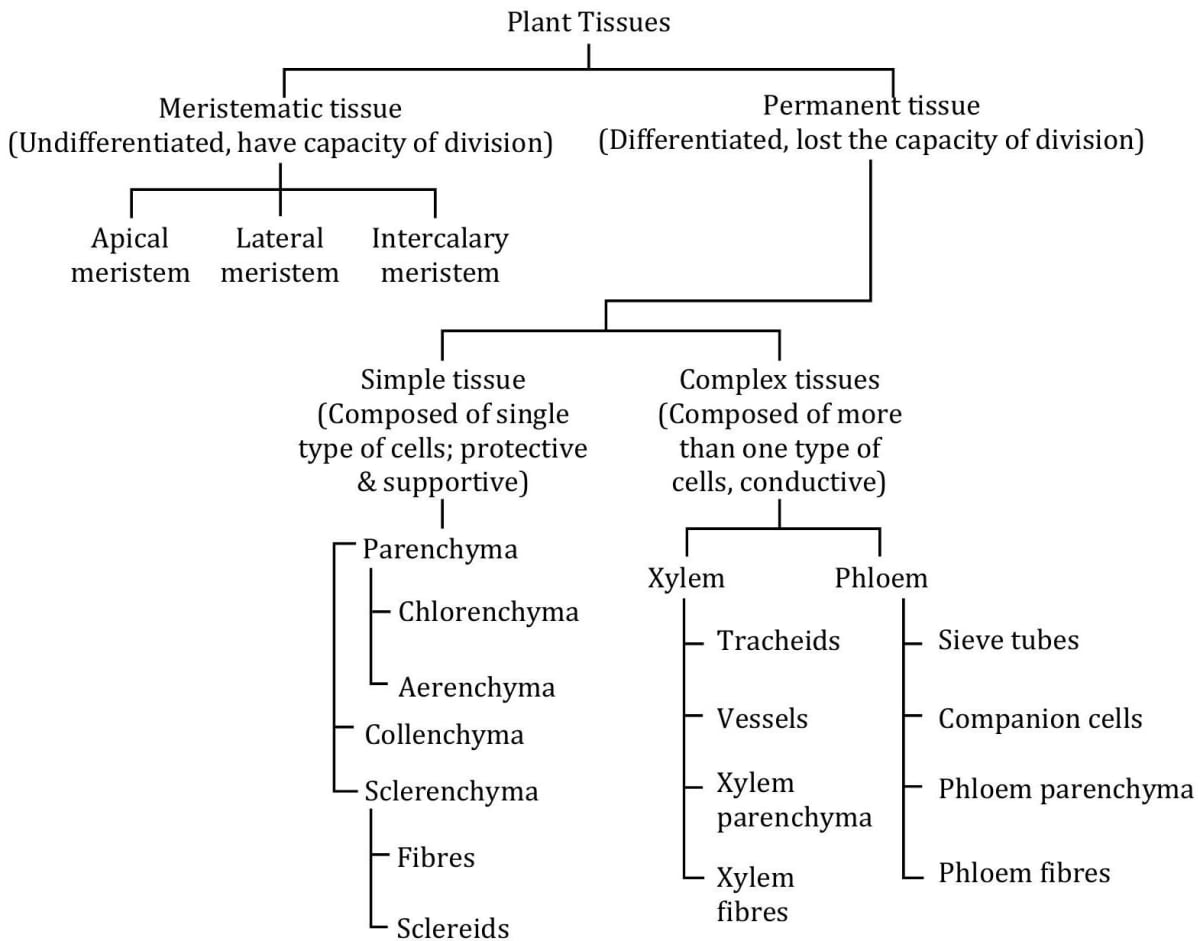
5.0Meristematic tissue
These are living tissues which are capable of division throughout life. These tissues are found in growing regions of plants. Cells have thin cell wall and are compactly packed with no intercellular space. Cells contain dense cytoplasm and do not have vacuoles. Cells

Meristematic Tissue contain prominent and large nucleus.
Meristematic tissues are free from virus because meristem has continuously and rapidly dividing cells. These cells have a high rate of metabolism and viruses cannot replicate in such cells.
Most of the viruses migrate through vascular elements but at the tip/meristem region, vascular elements are not formed. Thus, viruses cannot reach the meristem region.
Function
Meristematic tissue is responsible for the growth in length and width(girth) of plant body.
Vacuoles are absent in active tissue or meristematic tissue. Why it is so? In fast growing cells there is not much stuff to store. Therefore, vacuoles are very small or nonexistent.
Meristematic cells are metabolically highly active, so stored food is absent.
Classification of meristematic tissue
On the basis of their location, meristematic tissues are of three types-
- Apical meristem: It is present at the growing tips of shoot and roots. They are responsible for increase in the length of shoot and root. Root apical meristem is covered by root cap which protects it from getting damaged by the rubbing of soil particles.
- Intercalary meristem: These are present at the base of leaf or internode (on either side of the node). They are responsible for the growth in length of plant organs. Intercalary meristem may be present at the internode as in grasses, bamboo and mints or at the base of Pinus leaves.

- Lateral meristem (cambium) It lies on the lateral sides of stem and root or occurs along the sides of longitudinal axis of the plant. It helps in increasing the diameter (girth) of plant, hence helps in secondary growth.
Difference amongst three types of meristems
6.0Permanent tissue
They are formed by division and differentiation of meristematic tissue. They are composed of those cells which have lost the power of division (temporarily or permanent) and attain a permanent shape, size and function. Cells may be living or dead. Permanent tissues are of two types, simple permanent tissue and compound or complex permanent tissue.
Simple permanent tissue
These tissues are made up of similar types of cells, that perform a common function. They are protective and supportive in nature. Simple tissues are of three types (i) Parenchyma (ii) Collenchyma (iii) Sclerenchyma
- Parenchyma It is a living and basic packing tissue which consists of relatively unspecialised cells. Cells of this tissue have thin cell wall which is made up of cellulose. Cells of this tissue have cytoplasm with small nucleus and large vacuole. The cells may either be closely packed or may have intercellular spaces.
- Functions:
This tissue provides support to the plant and help in storage of food.

Modification of parenchyma:
- Chlorenchyma Chlorenchyma is the type of parenchyma in which abundant quantity of chloroplasts (containing chlorophyll) are found. They are present in mesophyll of leaves.
- Functions Synthesis of food (Photosynthesis).
- Aerenchyma Parenchyma is made up of rounded cells which surrounds the large air cavities. It is found in aquatic plants or hydrophytes.
- Function It provides buoyancy to the aquatic plants to help them float.
What happens to the cells formed by meristematic tissue?
After the division in meristematic cells they become differentiated into permanent tissue and lose the ability to divide.
- Collenchyma (Flexible tissue)
Cells of this tissue are living, elongated or vary in structure.
Cells of this tissue are irregularly thickened at the corners due to the deposition of pectin. It is present below the epidermis in stem of some plants and also present at leaf stalk and leaf margin. Intercellular spaces are usually very little between cells of this tissue.
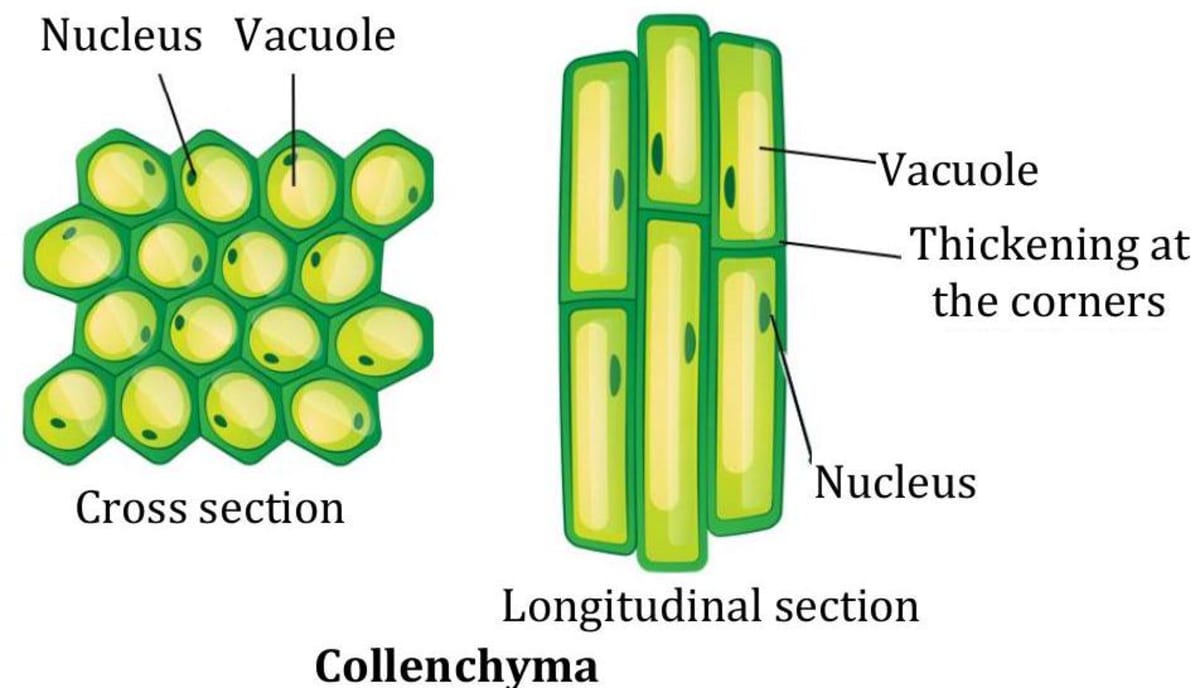
- Functions It provides mechanical support (tensile strength) and elasticity. It allows easy bending in various parts of plant (tendrils and stems of climbers) without breaking. It provides flexibility to plant.
- Sclerenchyma Sclerenchyma cells are dead, narrow and long cells and they are devoid of protoplasm. The walls of cells of sclerenchyma are greatly thickened with deposition of lignin. Such cell walls are called lignified. The cells of sclerenchyma are closely packed without intercellular spaces. They are found in stems of some plants (around the vascular bundle), orchid roots, veins of leaves, husk of coconut, hard coverings of seed and nuts.
- Functions
It is the main mechanical tissue which provides mechanical support. It makes the plant hard and stiff.

Sclerenchymatous cells are of two types in structure:
- Fibres
- Sclereids
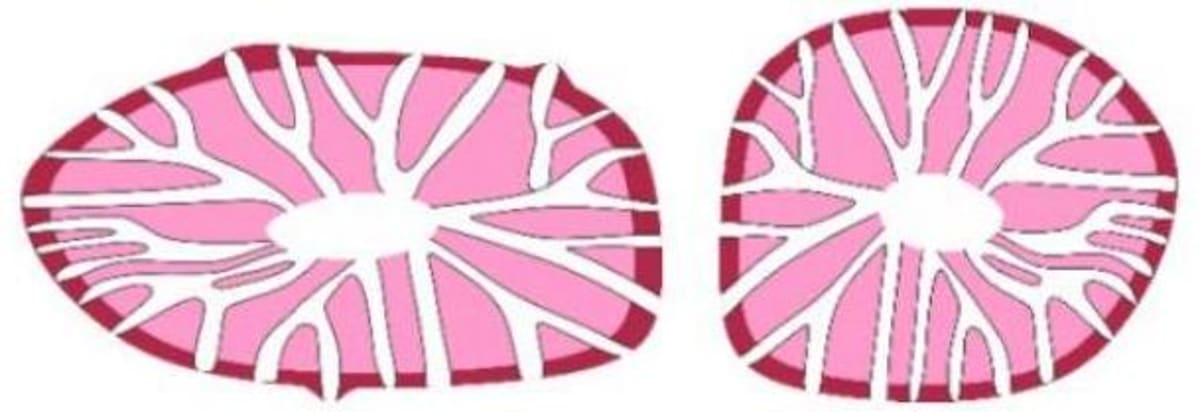
Sclerenchyma fibres: They constitute the major mechanical tissue of the plants and are abundantly found in plants. Commercial fibres obtained from plants (e.g. jute, flax, hemp) usually are sclerenchymatous fibres. Husk of coconut is made up of sclerenchymatous tissue.
Sclereids: They are highly thickened and irregularly shaped dead cells. They are found in various parts of the plant such as cortex, pith, phloem, hard seed coats. Sclereids provide strength to seed covering and grittiness to the pulp of many fruits, such as guava, apple and pear.
Comparision between Parenchyma, Collenchyma and Sclerenchyma
Compound or Complex Permanent Tissue
The complex tissues consist of more than one type of cells. All these cells coordinate to perform a common function. Complex tissues are of the following two types: (i) Xylem or wood (ii) Phloem or bast
(i) Xylem or wood: Xylem is made up of four types of cells:
Dead elements (a) Tracheids (b) Tracheae or vessels (c) Xylem fibres Living element (d) Xylem parenchyma
- Vascular bundles consist of xylem and phloem and both are known as conducting tissue. They transport water, mineral and food materials respectively from one part to another part of the plant body.
(a) Tracheids: Tracheids are elongated cells with tapering ends. Since tracheids do not have open ends like the vessels, so the water has to pass from cell to cell via the pits. Tracheids are the chief water conducting elements in non-flowering plants. i.e. gymnosperms.
(b) Vessels or tracheae: Very long tube-like structures formed by a row of cells placed end to end. Vessels are present in flowering plants i.e. angiosperms only. The transverse walls between the vessels are completely dissolved to form continuous channels or water-pipes. Tracheids and vessels help in long distance conduction of water and minerals vertically upward from the root system to various parts of plant. Tracheids and vessels also provide mechanical support.
(c) Xylem fibre: These are dead and lignified sclerenchymatous cells which are mainly supportive in function.
(d) Xylem parenchyma: It is formed of living parenchymatous cells which helps in storage of food and radial conduction of water and minerals.
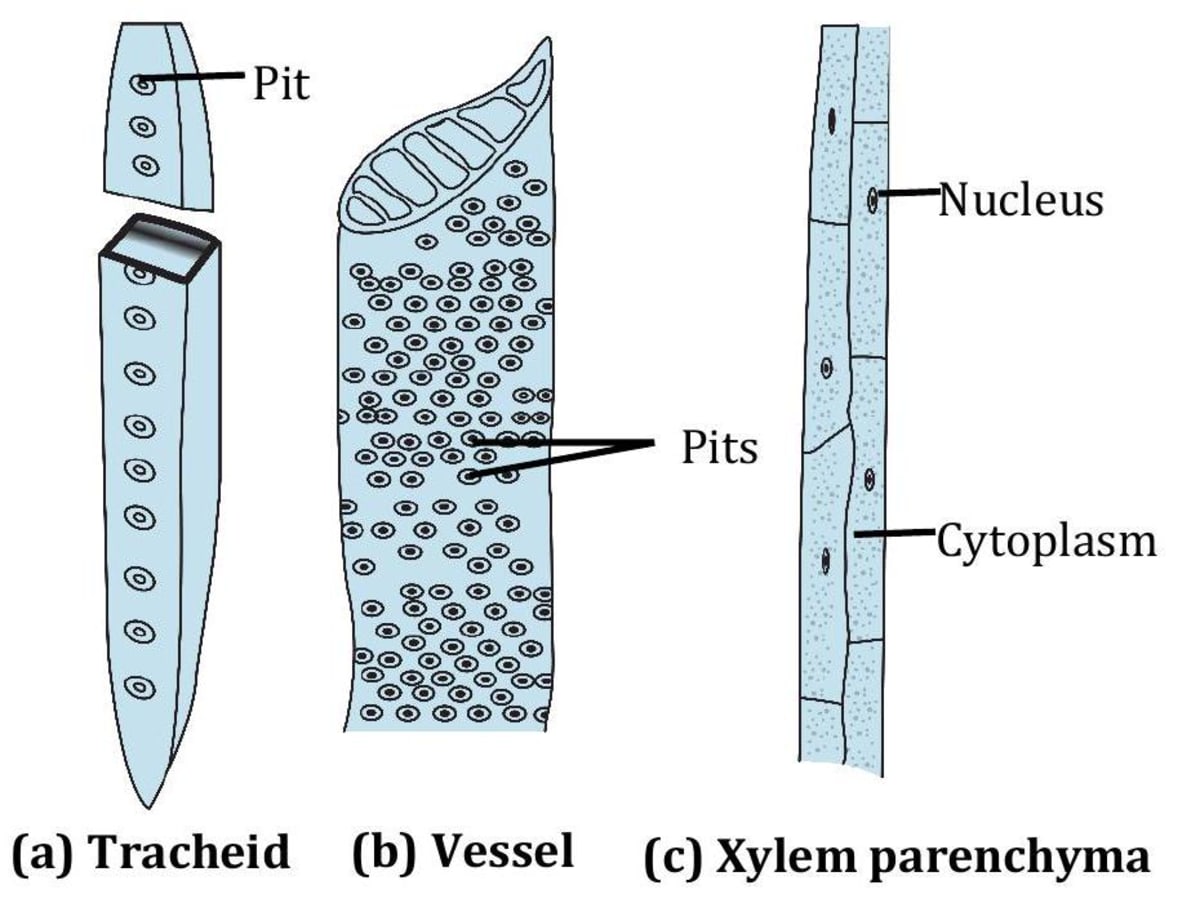
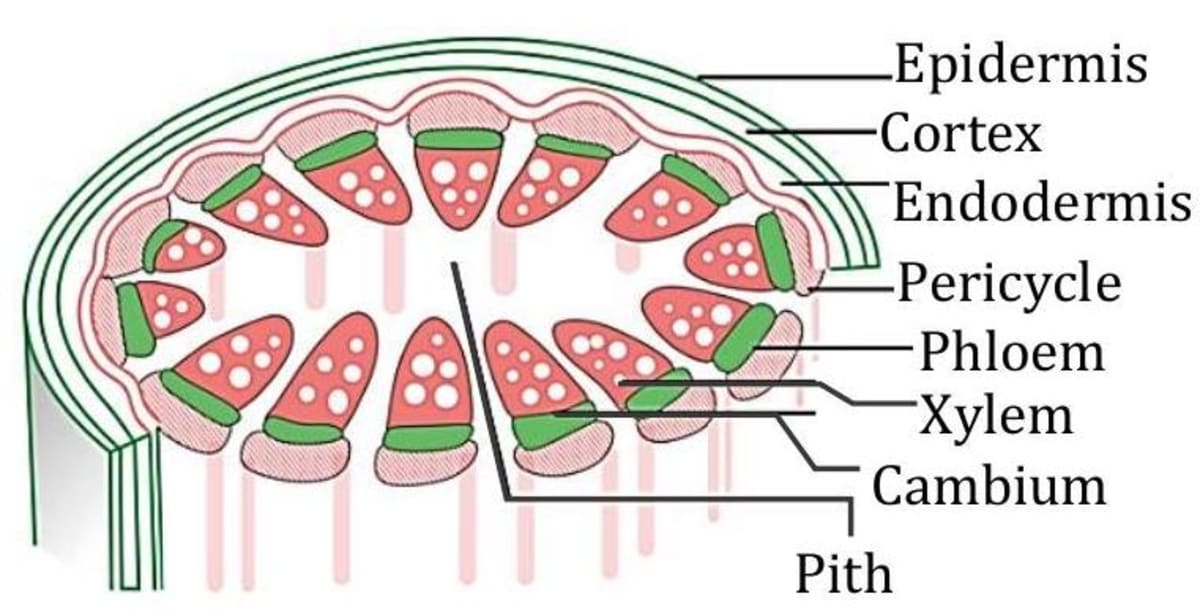
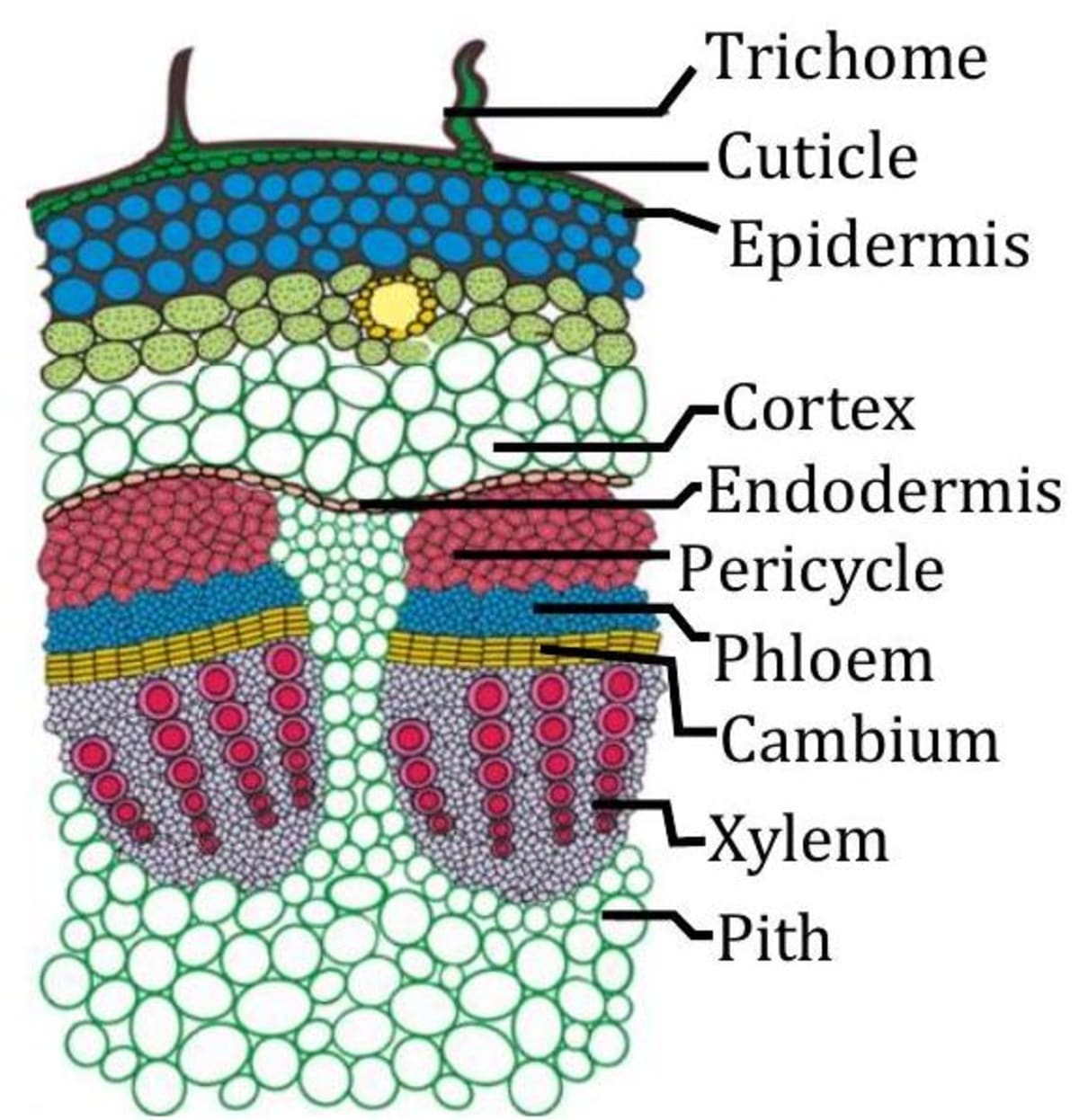
(ii) Phloem
It is also made up of four types of cells Living elements: (a) Sieve tubes (b) Companion cells (c) Phloem parenchyma Dead element: (d) Phloem fibres
(a) Sieve tubes: Sieve tubes are slender, tube like structures composed of elongated thin-walled cells, placed end to end. Their end walls are perforated by numerous pores and are called sieve plates. Wall of sieve tube is perforated. The nucleus of each sieve tube degenerates at maturity, however cytoplasm persists in the mature sieve tube. Thus, nuclei are absent in mature sieve tube elements.
(b) Companion cells: These are associated with sieve tubes. These are smaller cells having dense cytoplasm and prominent nucleus. The companion cells help the sieve tubes in the conduction of food material.
(c) Phloem parenchyma: These are living and thin walled cells which helps in sideways conduction of food. It stores various materials like resin, latex and mucilage.
(d) Phloem fibre: Phloem fibres are dead sclerenchymatous cells. Phloem or bast fibres of some plants are source of commercial fibres e.g. Jute, Hemp, Flax.
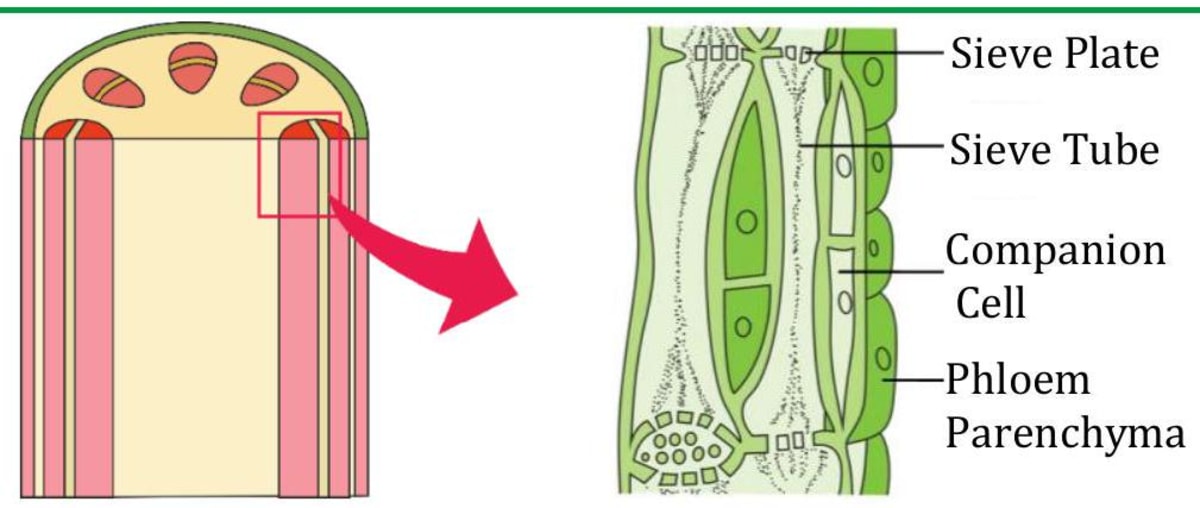
- Function of phloem Phloem transports photosynthetically prepared food materials in both direction from the leaves to the storage organs and later when required from storage organs to the growing regions of the plant body.
Differences betweeen Xylem and Phloem
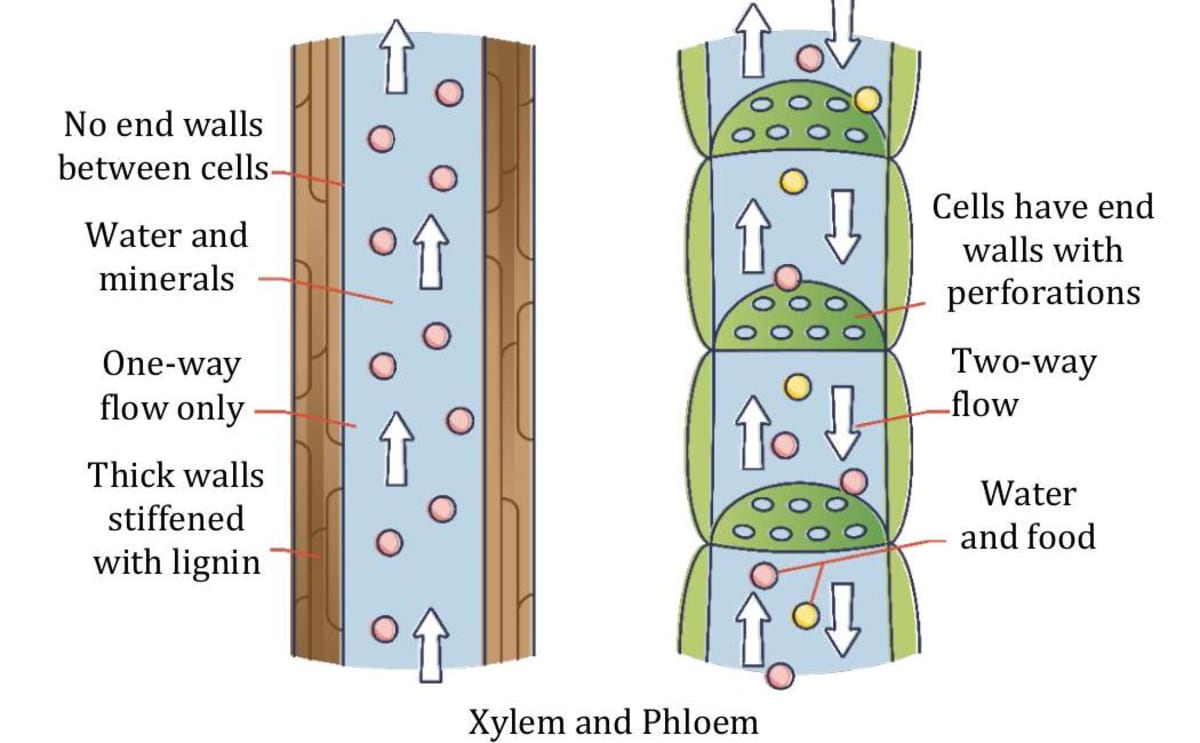
Although sieve tube elements do not have nuclei, but they still remain living. Explain.
It is so because they are dependent on adjacent companion cells which develop from the same original meristematic cell. The two cells together form a functional unit.
Differences between Meristematic tissue and Permanent tissue
7.0Protective tissue
These tissues are primarily protective in function. They are of two types: (i) Epidermis (ii) Cork
- Epidermis It is the outermost layer of all organs of plant body which is formed from parenchymal cells. In epidermal cell outer walls are thicker than inner wall. It is mostly single layer but in desert plant it is multilayered for protection against water loss. It protects the internal tissue from mechanical injuries and entry of germs.
- Cuticle: The outer wall of epidermis of aerial parts of plant secretes and deposits a waxy substance, called cutin which form a waterproof layer called cuticle.
It checks the loss of water by transpiration, mechanical injuries and invasion by parasitic fungi.
Epidermis

- Stomata: Epidermis of leaves has large number of microscopic apertures called stomata. Each stomata is an elliptical aperture bounded by two kidney shaped guard cells which regulate opening and closing of stomata.
Guard cells contains chloroplast unlike other epidermal cells hence they can perform photosynthesis.
Transpiration (loss of water in the form of water vapours) takes place through stomata. Stomata helps in exchange of gases.

- Root hairs: Epidermis of roots (epiblema) have root hairs which greatly increase their surface area for absorption of water and minerals.
- Function of epidermis
(i) It gives mechanical support and strength to plants parts. (ii) It protects the internal tissues from injuries and invasion by pathogens. (iii) It reduces the rate of transpiration by developing cuticle. (iv) Exchange of gases and transpiration take place through stomata. (v) It bears unicellular or multicellular appendages in the form of root hairs, stem hairs, glands etc.
- Cork or Phellem
Cork is the peripheral tissue of old stems and roots of woody trees and is formed due to activity of cork cambium or phellogen (secondary lateral meristem). Cork cambium (phellogen) produces new cells on its both sides, thus, forming cork (phellem) on the outer side and the secondary cortex or phelloderm on the inner side. It is made up of dead cells with thick walls but no intercellular spaces.
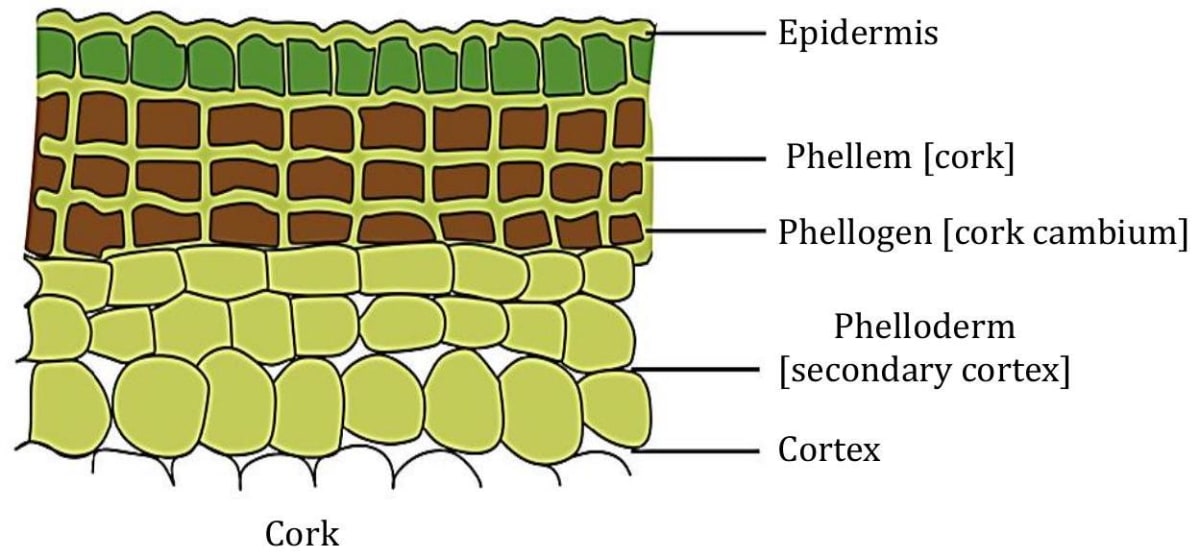
- Commercial importance of Cork Commercial cork is obtained from the stem surface of cork oak (Quercus suber). Cork is light and highly compressible which does not catch fire easily. Cork is used in the making of a variety of sport goods such as cricket balls, table tennis, shuttlecocks, wooden paddles etc.
- Functions of Cork (i) Cork checks the entry of harmful microorganisms into plant parts. (ii) Multilayered, impervious cork prevent loss of water by evaporation. (iii) Cork provides protection against mechanical injury, extreme temperature and fire.
Note: The walls of cork cells are heavily thickened by the deposition of an organic substance (a fatty substance), called suberin. Suberin makes these cells impermeable to water and gases and it also helps in conservation of water in the trees.
8.0Animal Tissue
Every animal, whether it is unicellular or multicellular, is capable of performing all vital functions such as respiration, ingestion, excretion and reproduction.
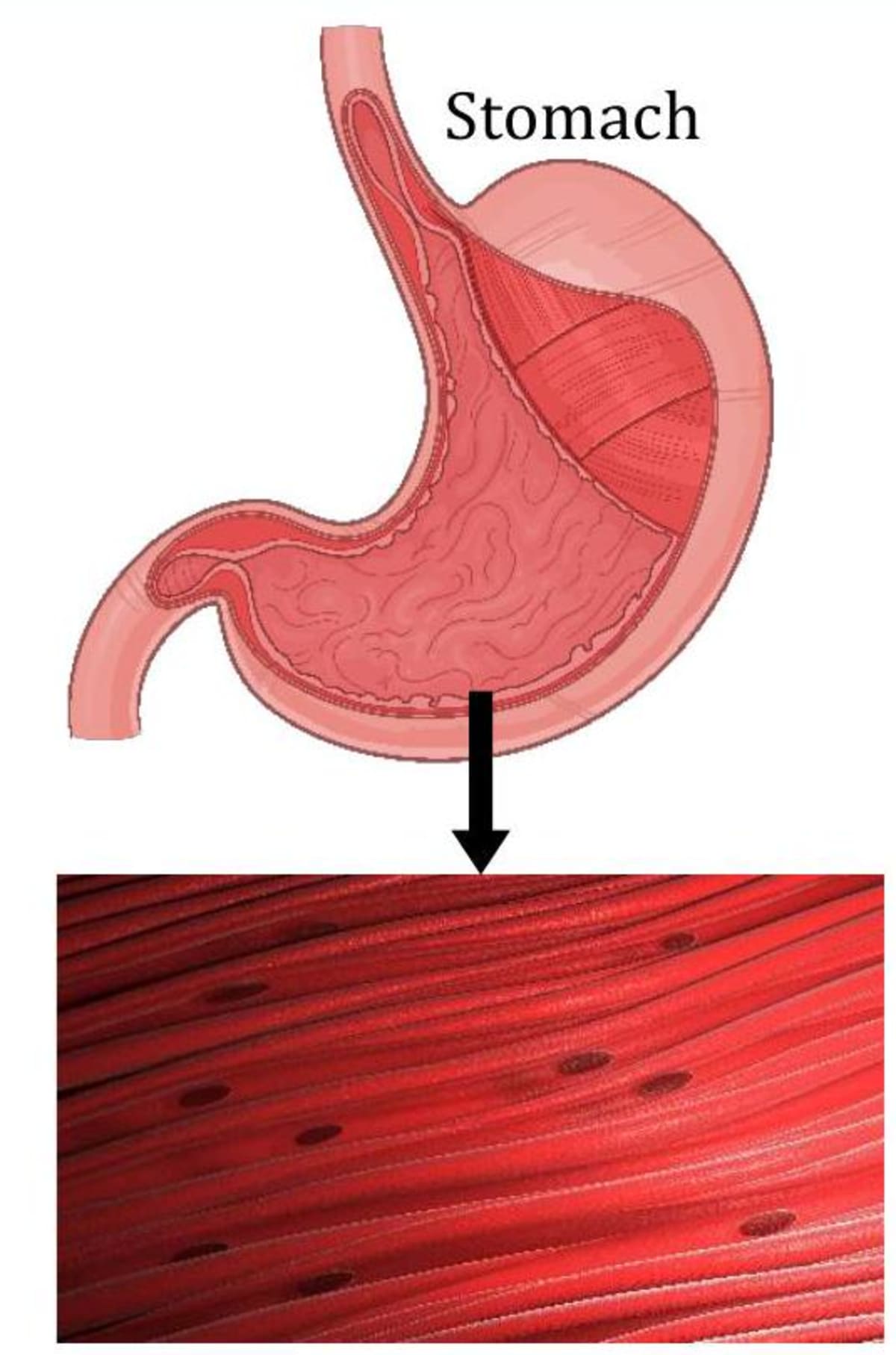
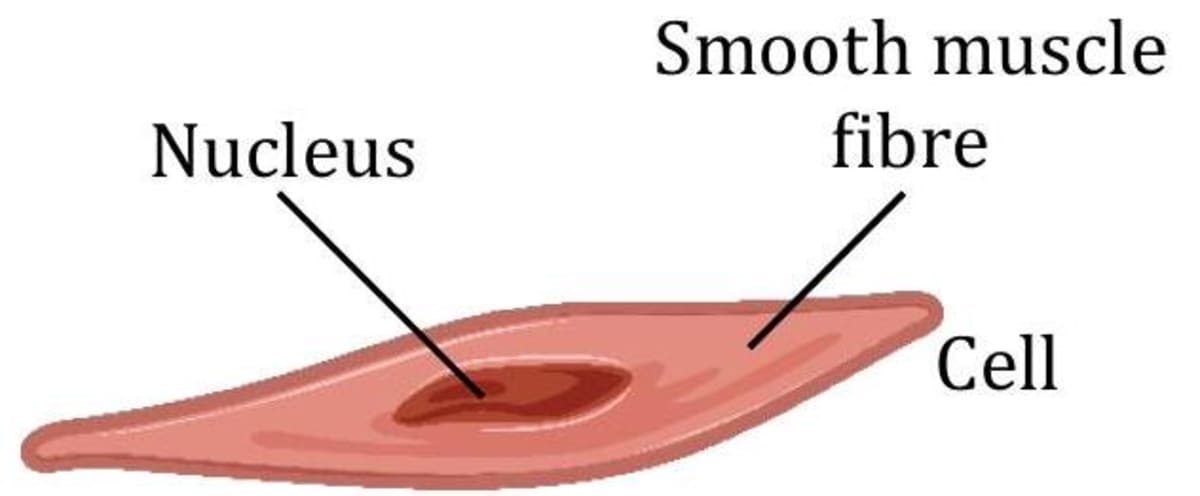
Types of animal tissue: Based on the location and function, the animal tissues are classified into four types -

9.0Epithelial Tissue
Word epithelium is composed of two words Epi-upon, Thelio-grows. (Means - A tissue which grows upon another tissue is called epithelium).
- Nature It is the simplest tissue. It is the protective tissue of animal's body. It covers most organs and cavities within the body. It also forms a barrier to keep different body systems separate. Epithelial cells are closely packed and have small amount of cementing material, so there are very little inter-cellular spaces present between the cells. Due to absence or less of intercellular spaces; blood vessels, lymph vessels and capillaries are unable to pierce this tissue, so blood circulation is absent in epithelium. Hence cells depend for their nutrients on the underlying connective tissue. It always rests upon underlying connective tissue. At the junction of the epithelial tissue and connective tissue a layer is present which is called basement membrane (extra cellular fibrous), which is formed of mucopolysaccharides and collagen fibrils.
"Skin forms the outer covering of our body" Give reason why skin is considered as an organ instead of tissue?
It is because skin is made up of different tissues which collectively perform a specialized function (protection). The two main layers of skin - (1) epidermis (epithelial tissue) (2) dermis (connective tissue). Skin epithelial cells are arranged in many layers to prevent wear and tear so it is called stratified squamous epithelium.
- The epithelial tissue can be simple (single layered) or stratified (multilayered). Simple squamous epithelium forms the lining of blood vessels and alveoli of lungs. Stratified squamous epithelium is found in skin, buccal cavity and esophagus.
Types of epithelial tissue on the basis of shapes and functions
- Squamous epithelium (scale like)
Description: Flattened cells, extremely thin.
Common locations: Walls of blood vessel, air sacs of lungs, oesophagus, lining of mouth.
Squamous epithelium (scale like) Function: Diffusion

- Stratified epithelium
Description: When cells of epithelium are arranged in layers, it is called Stratified epithelium.
Common locations: Skin, Vagina etc.
Stratified epithelium Function: Protection

- Cuboidal epithelium
Description: Cube like cells, may have microvilli at its free surface.
Common locatsions: Lining of kidney tubules, ducts of salivary
Cuboidal epithelium glands. It also forms germinal epithelium of gonads.
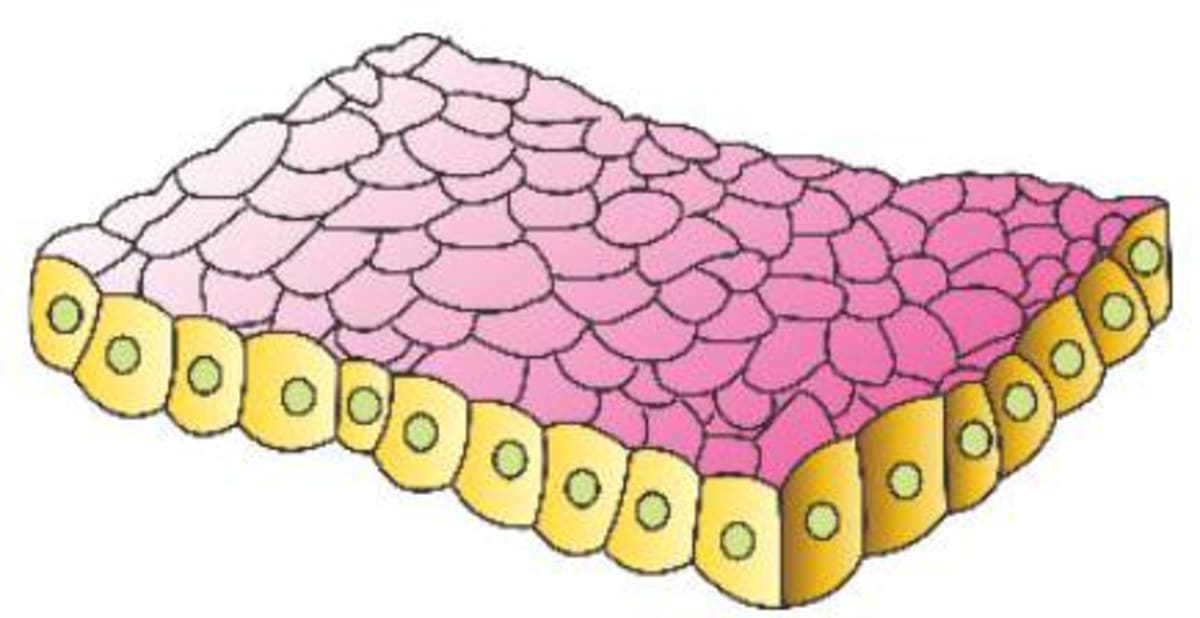 Columnar(pillar like) lining. Function: Secretion, absorption.
Columnar(pillar like) lining. Function: Secretion, absorption.
Modification of columnar epithelium
- Glandular epithelium Description: Tall, slender cells, some cells from the free surface invaginate inside to form secretory cells- goblet cells. Common location: Lining of intestine & glands, trachea, bronchi. Function: Secretion of mucus and other secretions.
- Ciliated columnar epithelium Description: Tall, slender cells which possess cilia. Common location: Lines the nasal passages, oviducts, terminal bronchioles. Function: Protection, movement of substances in a particular direction for e.g. of mucus in nasal passages, egg in oviduct.
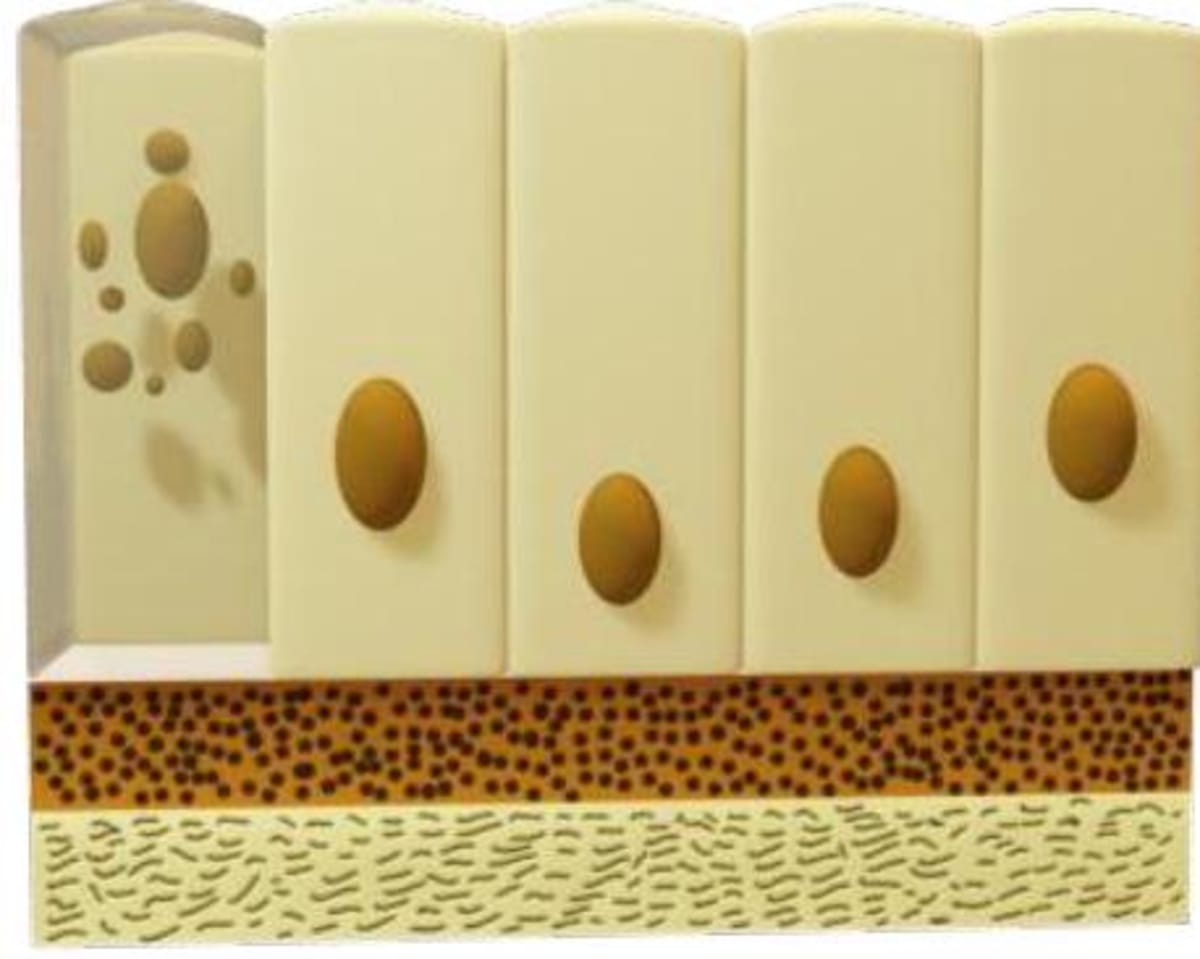
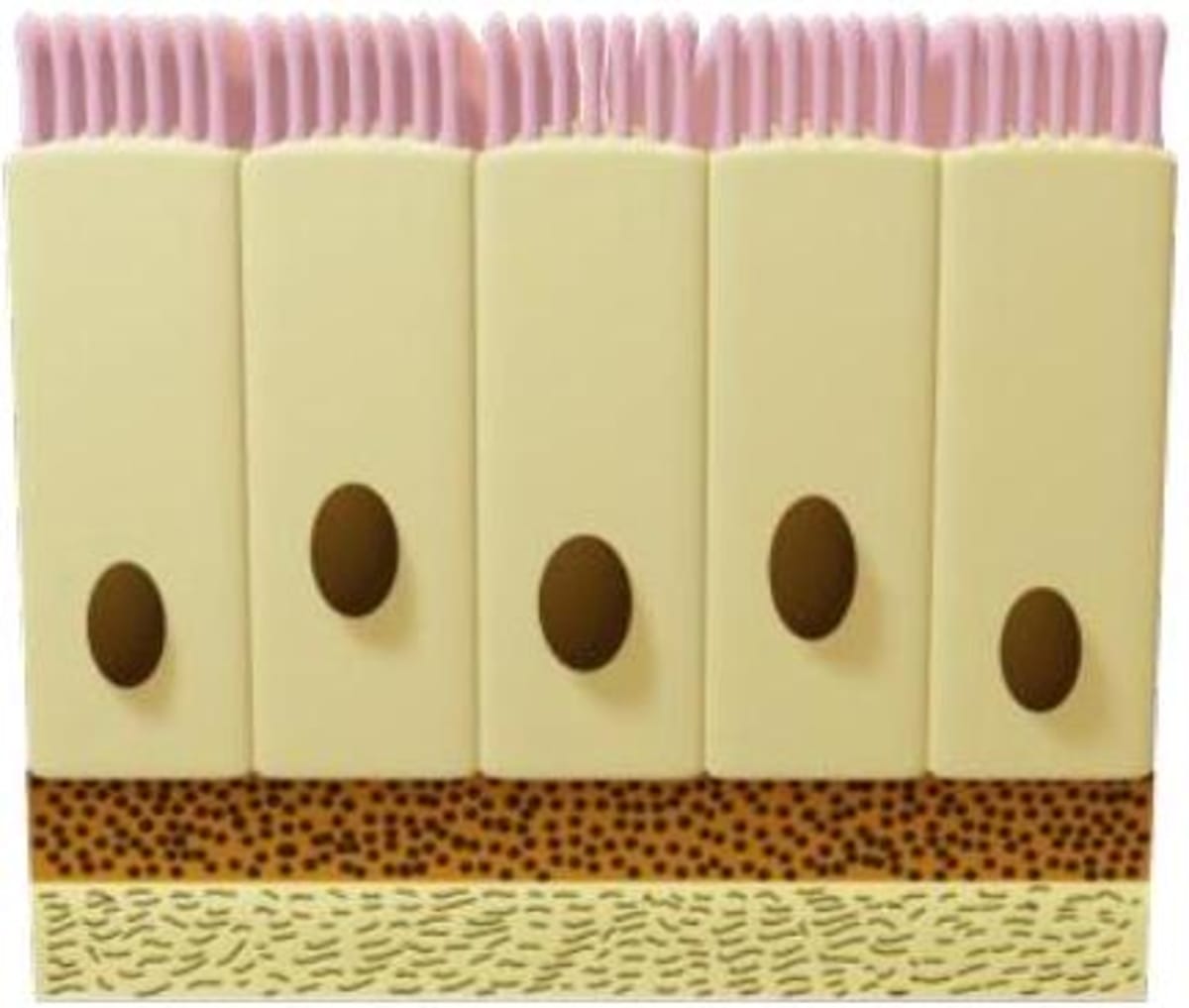
What are the functions of cilia and microvilli present on the surface of epithelial tissue?
Cilia show rhythmic beating movements in the respiratory tract. Thus, this beating of cilia help to keep unwanted particle from entering the lungs. The microvilli are finger like projections on the epithelial cells of intestine & kidney tubules where they help in increasing the surface area for absorption.
10.0Connective Tissue
The cells of connective tissue are loosely spaced and embedded into a noncellular matrix. The matrix may be solid (as in bone), soft (as in loose connective tissue), or liquid (as in blood). On the basis of nature of matrix, major types of connective tissue are: (i) Loose/ areolar connective tissue (ii) Adipose tissue (iii) Fluid / vascular connective tissue (iv) Fibrous / Dense regular connective tissue (v) Skeletal connective tissue
Loose connective tissue
Loose connective tissue is a mass of widely scattered cells whose matrix is a loose weave of fibres. Many of the fibres are strong protein fibres called collagen. Loose connective tissue is found beneath the skin and between organs. It is a binding and packing material whose main purpose is to provide support, to hold other tissues and organs in place.
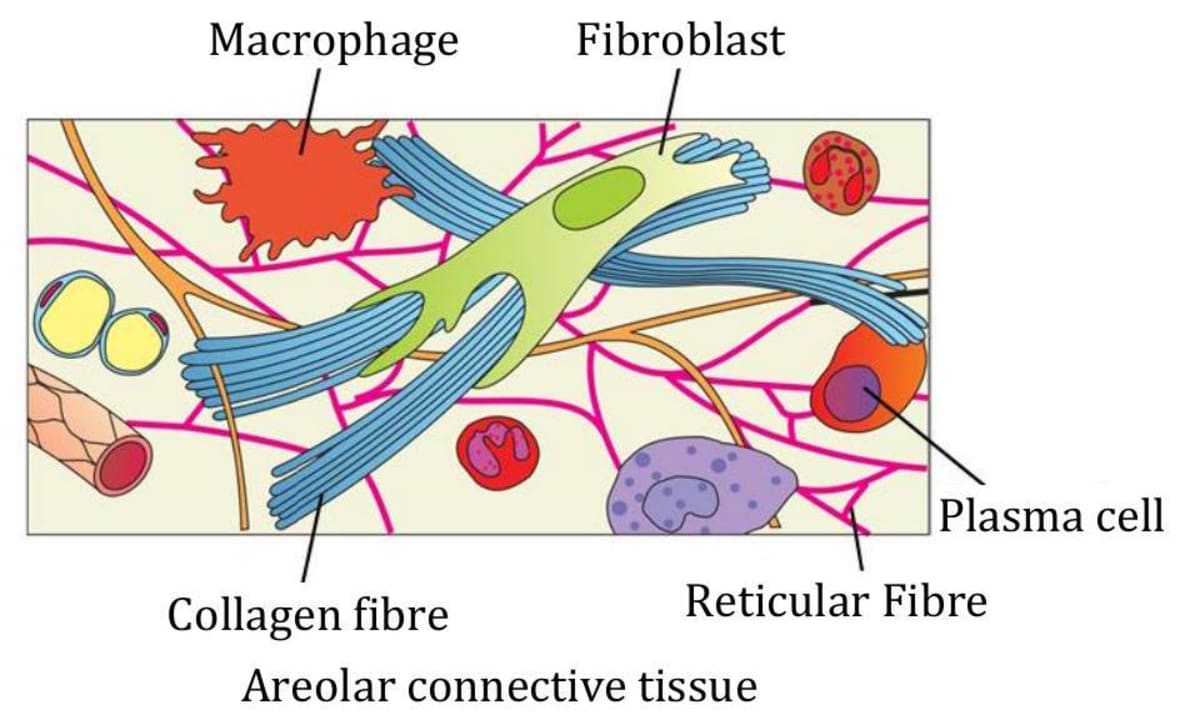
Adipose Tissue
It consists of adipose cells (Adipocytes) filled with fat globules in loose connective tissue. Each adipose cell stores a large droplet of fat that swells when fat is stored and shrinks when fat is used to provide energy. Adipose tissue pads and insulates the animal body.
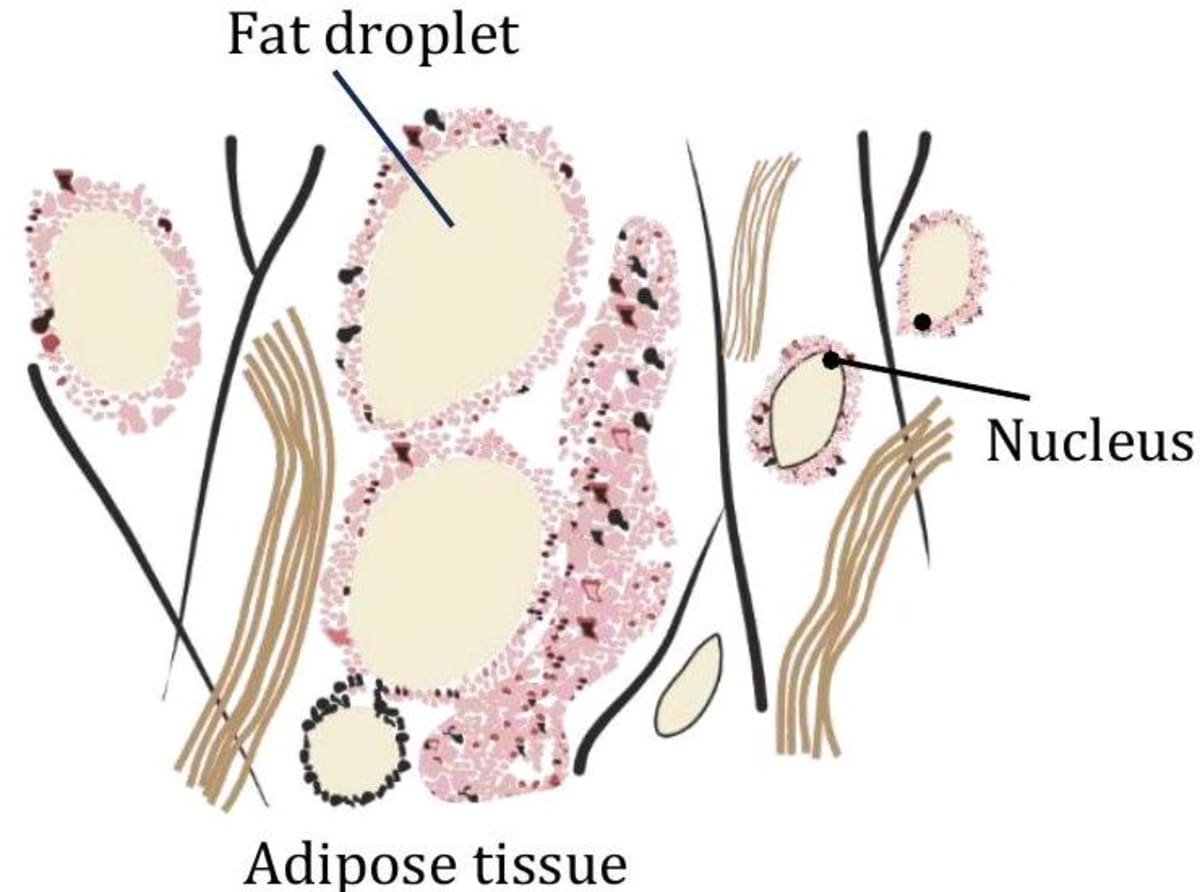
Fluid/Vascular Connective Tissue
It is a special type of connective tissue which maintains link among different parts of the body. It receives materials from certain parts of the body and transports them to the other parts. It constitutes the transport system of animals. It consists of two basic components - blood and lymph.
Blood
Blood is a connective tissue of cells separated by liquid matrix called plasma. It lacks fibres in its matrix. Blood constitutes 55 percent of plasma and 45 percent blood corpuscles. Plasma contains water, salts, sugars, lipids, amino acids etc.
- Blood corpuscles are of 3 types: (i) Red blood cells or erythrocytes. (ii) White blood cells or leucocytes (iii) Platelets or thrombocytes. Functions of blood: (i) It transports nutrients, hormones and vitamins to the tissues and carries excretory products from the tissues to the excretory organs. (ii) The RBC's of blood helps in the transport of respiratory gases, Blood oxygen & . (iii) The WBCs fight with diseases by producing antibodies and engulfing the germs (antigens). Neutrophils are polynuclear leucocytes. (iv) Blood platelets helps in the clotting of blood. (v) Blood helps in thermoregulation, water balance and maintenance of pH of body.
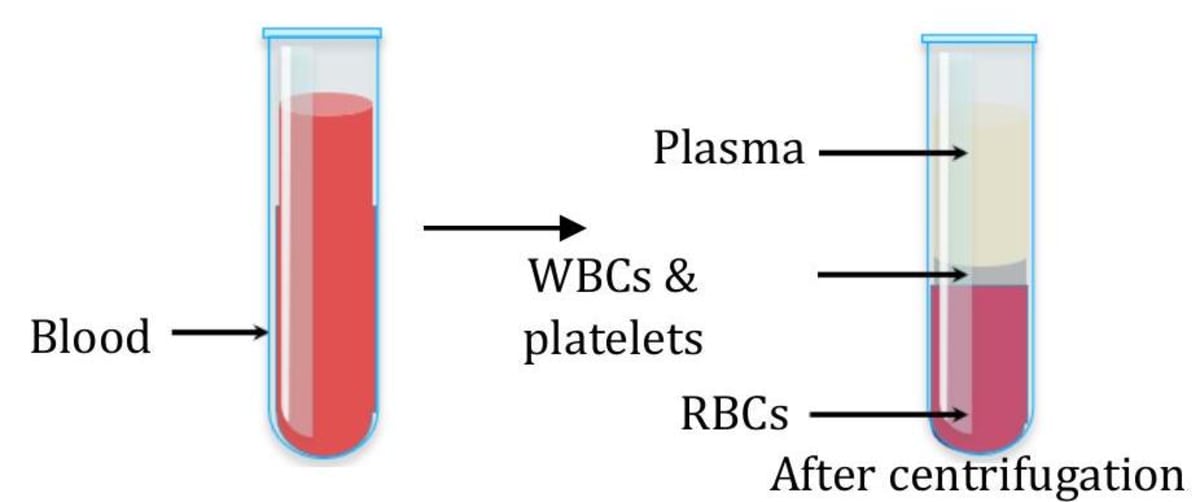
What will happen if the epithelial lining of the capillaries is multilayered?
If this happens, then permeability of capillaries will be affected so that exchange of substances by diffusion will not take place.
Lymph
Lymph is actually filtered blood which is similar to blood in composition except that it is devoid of RBC, platelets and some blood protein. WBCs are present in abundance in lymph. Due to the absence of haemoglobin, lymph is colourless.
- Functions of lymph (i) Helps in the transport of nutrients. Nutrients that filter out from blood capillaries into lymph are transported back by lymph into blood through heart. (ii) Helps in the transportation of fat absorbed from intestine to the blood. (iii) Keeps the tissues and organs of the body moist. (iv) Lymphatic organs (lymph nodes, spleen) produce lymphocytes which in turn produce antibodies to strengthen the immune system of the body.
Fibrous/dense regular connective tissue
This tissue consists mainly of fibres. The fibres are of 2 types:
(1) Collagen white fibres The dominance of the (white inelastic) collagen fibres contributes to the considerable mechanical strength of white fibrous tissue.
(2) Elastin yellow fibres It can stretch upto one and a half times their length then snaps back to its original length when relaxed.
Dense regular connective tissue occurs in two forms-
(a) Tendons These are cords of dense (white fibres) connective tissue that attach skeletal muscles to bones. They have great strength, but its flexibility is limited.
(b) Ligaments These are cords of yellow fibrous connective tissue containing elastin and collagen fibres having little matrix that connect one bone to the another.
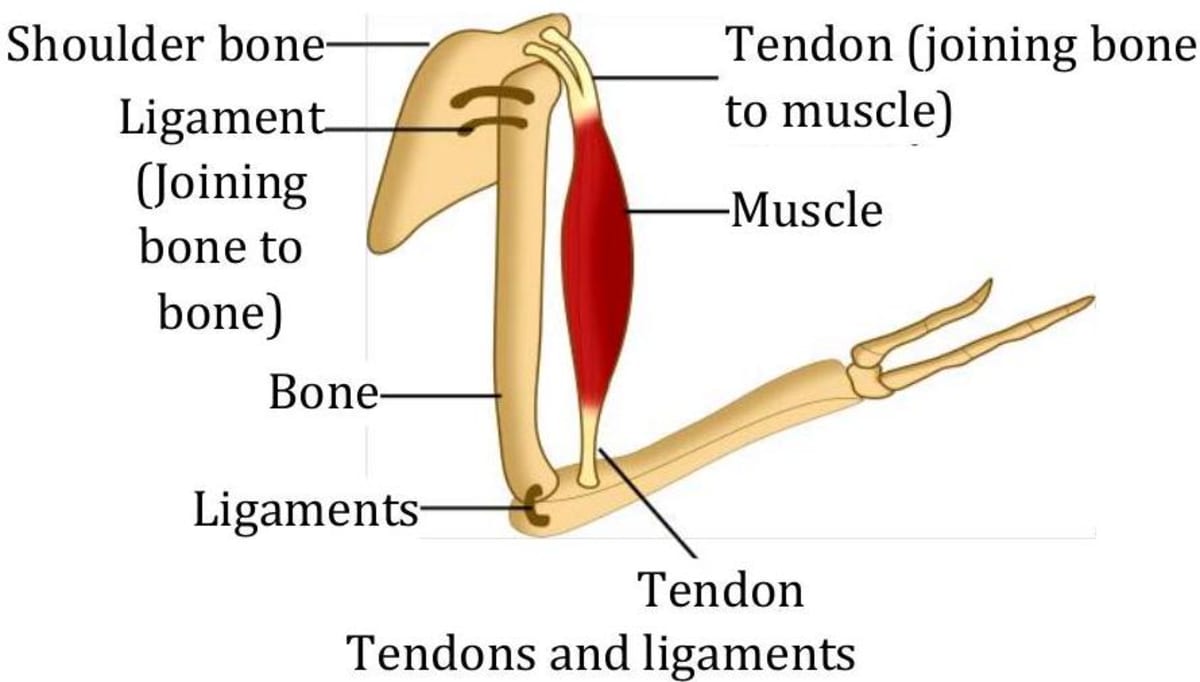
Skeletal Connective Tissue
It mainly consists of bones and cartilage, that provide a strong supportive framework for the body. In these connective tissues, the matrix contains numerous fibres and, in some cases, deposits of insoluble calcium salts.
Bone:
It is a rigid connective tissue that has a matrix of collagen fibres and salt of calcium and phosphorous compounds, giving it greater rigidity and strength. Most of the skeletal system is comprised of bone. Haversian system are the structural units of mammalian bone. It consists of Haversian canals, Haversian lamellae and osteocyte.
- Functions of bones (i) It provides support for muscle attachment. (ii) It protects the internal organs from mechanical injury. (iii) It serves as a reservoir for calcium.
- Immature bone cells (Osteoblast), mature bone cells (Osteocytes), Immature cartilage cells (Chondroblast), mature cartilage cells (Chondrocytes). Bone destroying cells (Osteoclast), cartilage destroying cells (chondroclast)
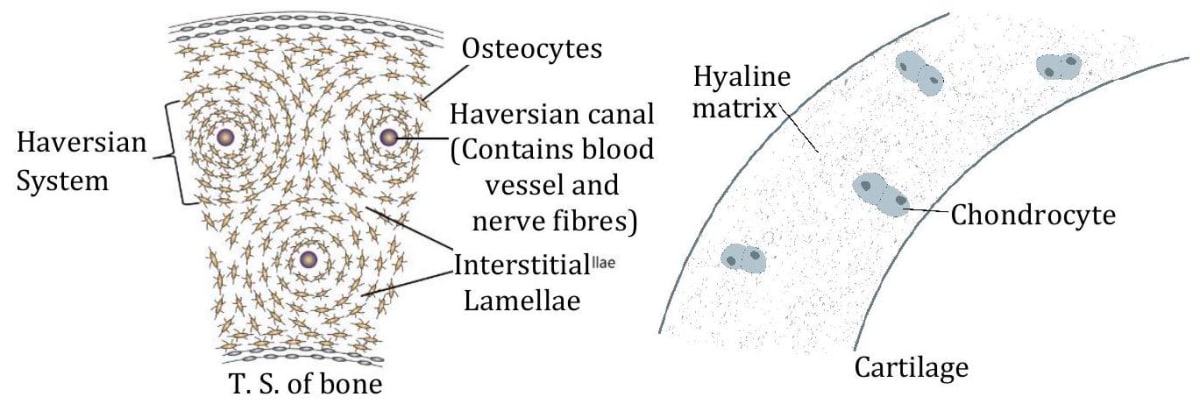
Cartilage:
It is a connective tissue with an abundant number of collagen fibres in a rubbery matrix. The matrix is made up of proteins and sugars. It is both strong and flexible but softer than bone. It forms the embryonic skeleton of vertebrates and the adult skeleton of sharks and rays. It also occurs in the human body in the ear pinna, tip of the nose, trachea, larynx and surrounding ends of joints such as knees.
11.0Muscular tissue :
Muscular tissue is distinguished from other tissues by its unique ability to contract & relax and thereby perform mechanical work. It is responsible for movement of body organs and locomotion of body.
- The presence of intercalated discs and oblique bridges are unique features of cardiac muscles. These help the muscles in faster conduction of wave of contraction.
- General structure The structural unit of muscular tissue is the muscle cells which because of its elongated shape is also called muscle fibre. The contractility is due to the presence of contractile proteins (actin & myosin) in the muscle fibre.
- General functions of muscular tissue
(i) It supports the bones and other organs of the body.
(ii) Muscles cause peristalsis of gut, heart beat, production of sound, etc.
(iii) Muscles cause movements of body parts and locomotion of the animals.
(iv) Facial expression also depends on muscles.
(v) Contraction of muscles causes delivery of a baby.

Differences between Skeletal muscle tissue, Cardiac muscle tissue and Smooth muscle tissue
12.0Nervous tissue:
The nervous tissue, contains densely packed cells called nerve cells or neurons, is present in the brain, spinal cord and nerves. The neurons are specialised for conduction of nerve impulses. They receive stimuli from within or outside the body and conduct impulses (signals) which travel from one neuron to another neuron. Nerve impulse allow us to move our muscles when we want to. The functional combination of nerve and muscle tissue is fundamental to most animals.
This combination enables animals to move rapidly in response to stimulus. Each neuron has following 2 parts :
Cyton or cell body:
Contains a central nucleus and cytoplasm with characteristic deeply stained particles called Nissl's granules (i.e. clumps of ribosomes and rough endoplasmic reticulum).
(ii) Cell Processes
- (a) Dendrites: These may be one to many, generally short and branched cytoplasmic processes. Dendrites are afferent processes because they receive impulse from receptor or other neuron and bring it to cyton.
- (b) Axon: It is single generally long efferent process which conducts impulse away from cyton to other neuron.
Longest cell in body is neuron because axon can be more than one metre long. Axon has uniform thickness, but it has terminal thin branches called telodendria. Terminal end buttons or synaptic knobs occur at the end of telodendria.
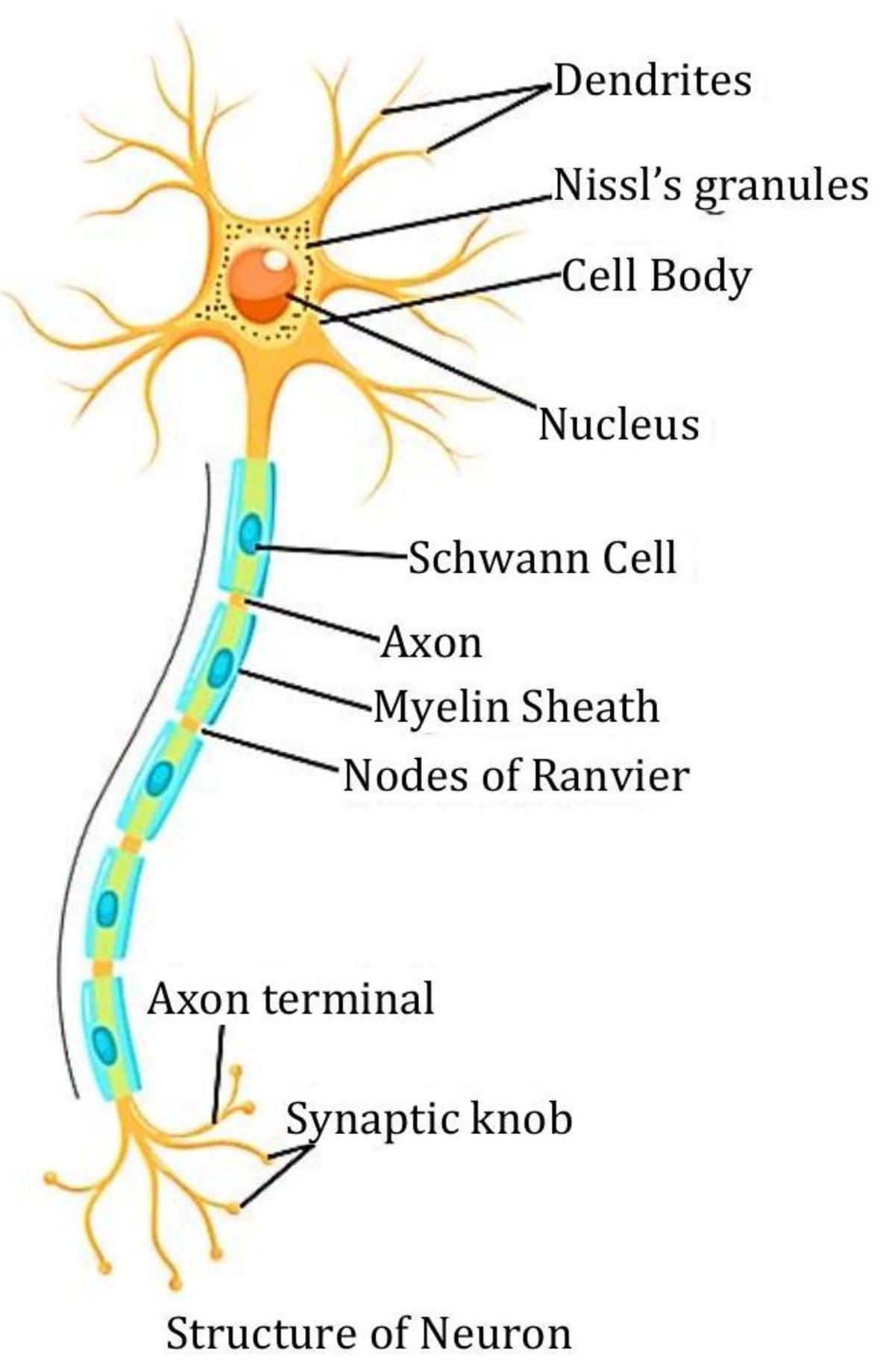
13.0Biology Diagrams made Easy

Parenchyma
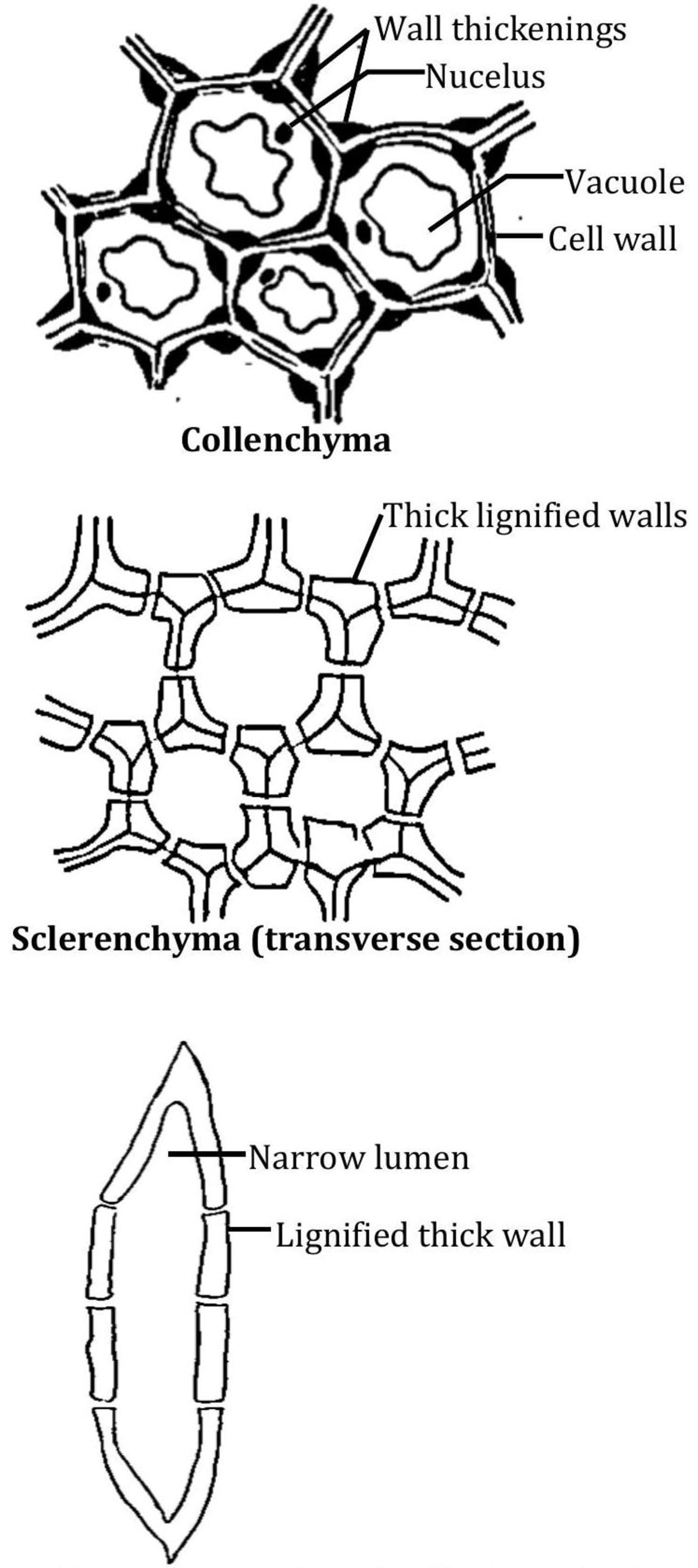
Sclerenchyma (Longitudinal section)
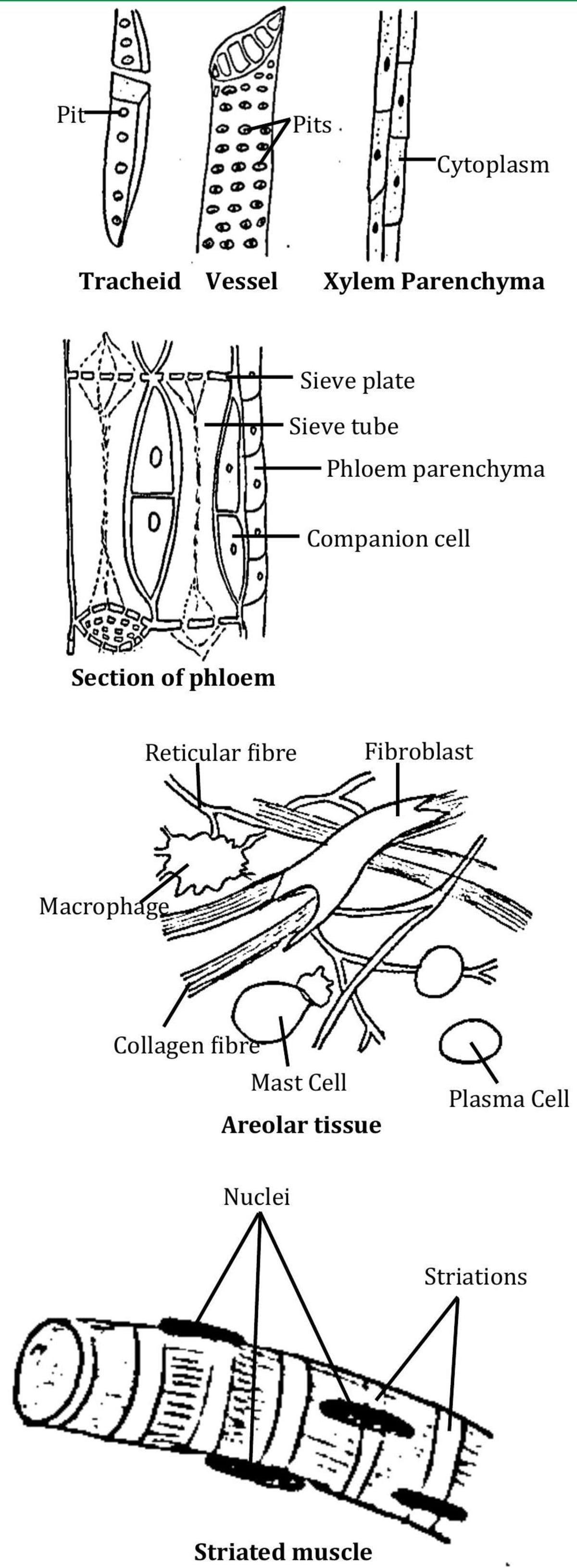
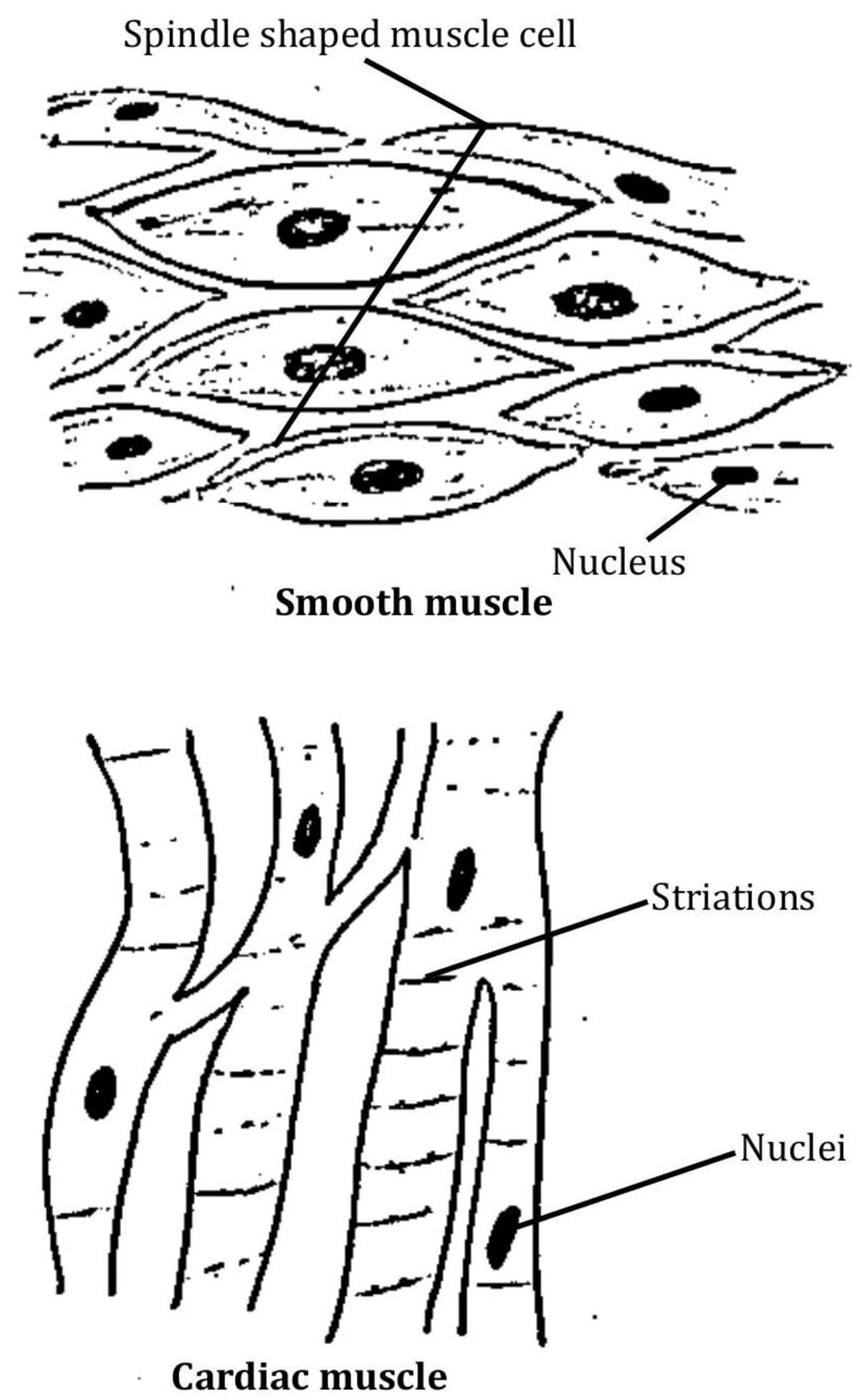
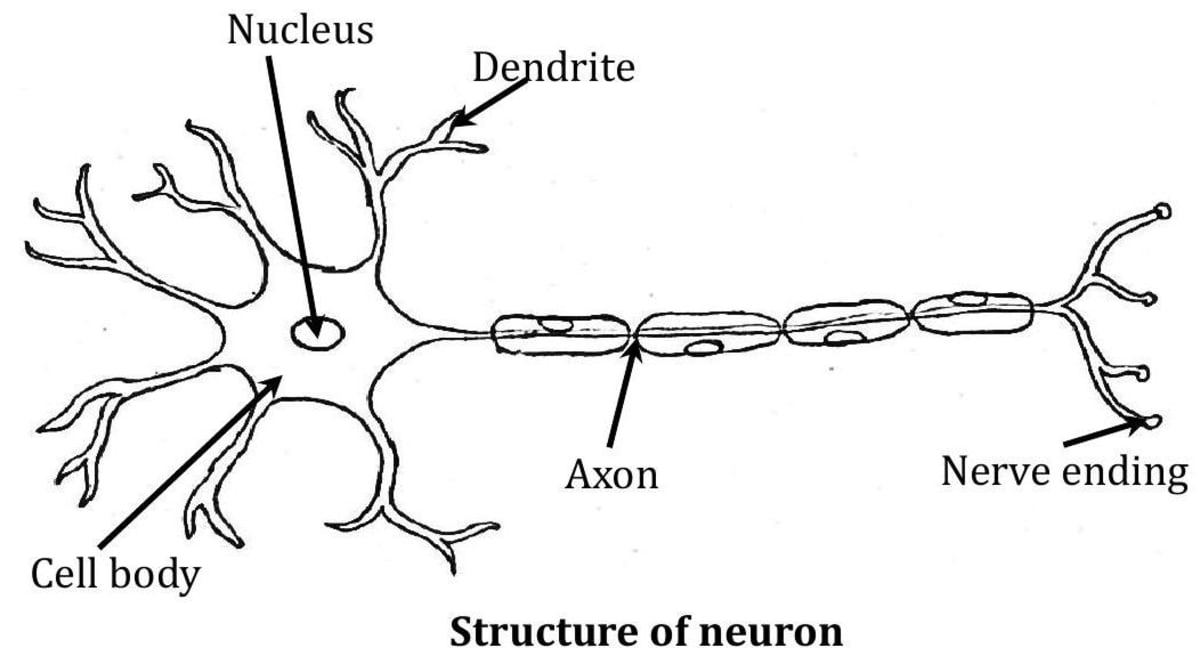
14.0Chapter At a Glance
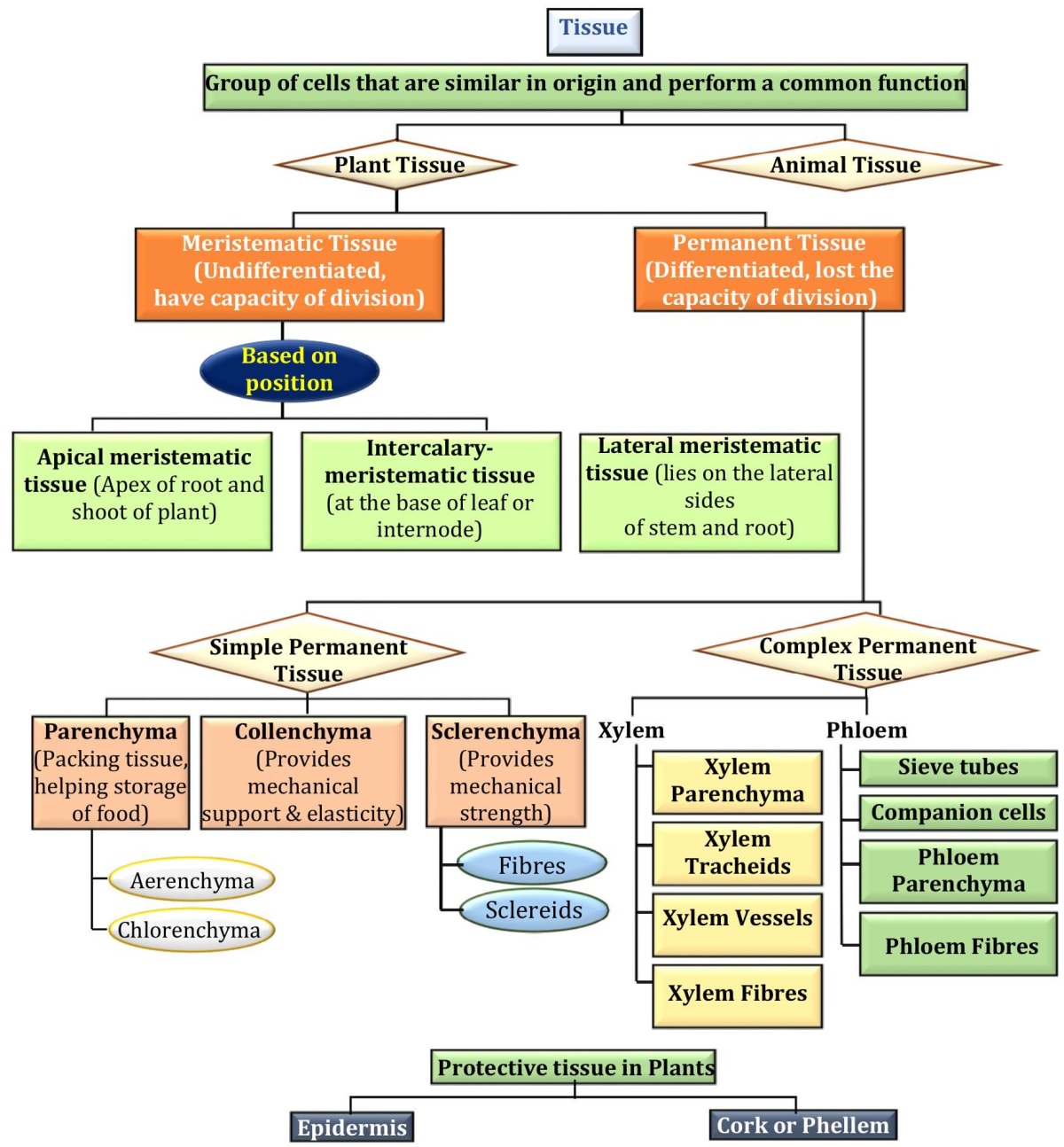
15.0SOME BASIC TERMS
- Cope: To deal successfully with.
- Prominent: Noticeable; easy to see.
- Longitudinal: Running lengthwise.
- Pathogens: Disease causing microorganisms.
- Microvilli: Large number of minute projection from the surface of some cells.
- Invaginate: Being turned inside out or folded back on inside to form a cavity or pouch.
- Peristalsis: Rhythmic contraction and relaxation of muscular walls of organs of digestive system like oesophagus and intestines.
- Stimulus: An agent or change in the environment that induces reaction in the body.
- Afferent: Bringing towards a part or organ.
- Efferent: Taking away from a certain parts or organ.
- Mesophyll: Chlorophyll containing cells.
- Tendril: A long thin part that grows from a climbing plant for support.
- Leaf stalk: A thin long structure which attaches leaves to a stem.
- Epidermis: The surface epithelium of skin/outer layer of tissue in plant.
- Striation: A long, thin line or mark.
- Gut: The long tube in our body through which food moves during the process of digesting food.
- Apex: Uppermost point.
- Tensile strength: Maximum stress caused by a pulling force.
- Antigens: Substance that stimulate immune response.
- Impulse: Movement of action potential in response to a stimulus along nerve fibre.
Related Article:-
Join ALLEN!
(Session 2026 - 27)